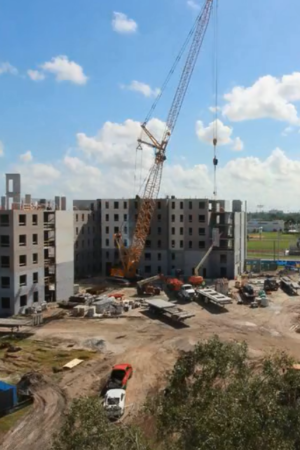Case Study: Precast vs Sitecast Concrete
Nova Southeastern University
Nova Southeastern University (NSU) was looking to build a 600-bed sitecast residence hall with a Spring 2020 delivery date. As experts in student housing construction, our team knew a mid-semester delivery date wasn’t an ideal scenario for the University. Juneau worked hand-in-hand with the architect and engineers, NSU and RISE to come up with a plan of action that would ultimately shorten the project schedule, but still deliver a best in class product for NSU. After further investigations, it was determined that a precast structure in lieu of the original cast in place structure would shave months off the project schedule and provide a cost savings to the project. The change in structure type ultimately shortened the project duration from 18-20 months to 16 months, allowing the building to be utilized by incoming students for the Fall 2019 semester.
Besides maintaining, and in most cases accelerating the project schedule, there are many benefits to using precast over sitecast concrete. A few benefits are: curing time/conditions, cost, and eco-friendliness. Since NSU is in Florida, there’s a constant threat of rain, delaying sitecast concrete pours. Using precast concrete prevented potential project delays due to the curing time and weather conditions. NSU had a significant cost savings of $3.6M by switching to the precast structure. Precast is also unique in that the architects are able to take advantage of the natural aesthetics that precast panels provide to the exterior of a building, enhancing the exterior façade and producing a sophisticated look to the concrete structure. Furthermore, exterior wall panels are pre-insulated which increases energy efficiency and provides a superior waterproofing system. Another advantage is little-to-no waste by using precast concrete since all pieces are prefabricated to a specific dimension and brought on site for installation.
One very important factor that plays into using a precast concrete structure on a tight timeline is leveraging VDC coordination early on. By involving VDC at an early stage on this project, we were able to begin coordination of the precast structure to allow for fabrication to begin off-site and ahead of mobilization. Together, Juneau and the design team developed MEP routings and coordinated with the precast engineers on specific wall and floor penetrations. The project had 2,300 unique precast panels, therefore early VDC coordination was essential in maintaining the overall project schedule.
“BIM was integral to the success of the Nova project. It allowed us to release the precast into production with certainty the components installed months later would fit. Mechanical, electrical, plumbing and fire protection rough-ins were all coordinated. Along with windows, doors, electrical equipment, and connections to structural steel building sections.”
– Jake Landreneau, VDC Services Director
Back to All Insights